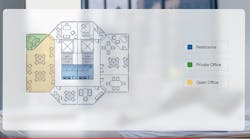As building owners and occupants recognize that lighting control improves the comfort and quality of any space, and codes require more advanced lighting control systems in retrofits and new construction, specifiers and contractors are increasingly called on to include lighting control in their project proposals.
Whether you are an engineer, facility manager, or electrical contractor, choosing the right wireless lighting control solution offers several advantages right from the start – easier to design, faster to install and set up than wired systems, and more cost effective in terms of time and material costs. Wireless also offers greater opportunity for centralized monitoring and control, resulting in lower costs and improved energy savings.
Starting with flexible system design
Compared to wired options, wireless solutions are typically less restrictive and easier to manage – for small projects, to spaces that will scale over time, to large projects with multiple space types, a variety of lighting performance requirements, and a well-defined budget. It’s important to choose a reliable, time-tested provider, and a system that can easily accommodate all these project requirements when and where you need it to.
What makes wireless easier and more cost-effective?
• Wireless controls and sensors are simpler to install, and easier to relocate and reprogram once they are installed.
• You won’t be locked into control locations or poor performance when onsite conditions change, or don’t perfectly match project drawings.
• Lower installation and implementation costs translates to lower bids from your installers and better value for your customers.
The right wireless solution is designed to easily scale from a single room to an entire building whenever time and budget allow, with no expensive rewiring, and minimal disruption to the space.
Which wireless solution is best for your project?
Look for a system provider that offers tools and support that make system design, specification, installation and setup easier.
• Online design tools can help you quickly generate one-line diagrams, bills of material, and handle specific product details easily, and then allow you to export all the information to a quotation tool when desired.
• Many project spaces are similar – ask if spec typicals are available to speed up system design, and still allow you to customize the project where necessary.
• Project profiles can help provide valuable insight, and illustrate how wireless systems accommodate unique installation challenges, and a defined sequence of operations. One example is Franklin & Marshall College in Lancaster, Pennsylvania – a project with historic buildings and a tight timeline, as well as multiple space types and varied control requirements.• Finally, LEDs are part of virtually every new project and lighting retrofit. Whether you are looking for 0-10V switching or high-performance dimming, look for a provider with proven LED expertise, a long history of digital control experience, and a demonstrated commitment to customer service and support. Choosing a wireless control solution should not mean you are limited to a specific fixture manufacturer. With a flexible, tested system like Lutron Vive, you can use more than 72,000 fixtures with no concerns about compatibility or performance.
Wireless lighting control solutions deliver the right amount of control for every space, meet budget and code requirements, and save you valuable time and money.
Interested in learning more? View the 3 Ways Wireless Lighting Control Helps Contractors webinar. Looking for in-person training or assistance with your next project? Ask Lutron.



